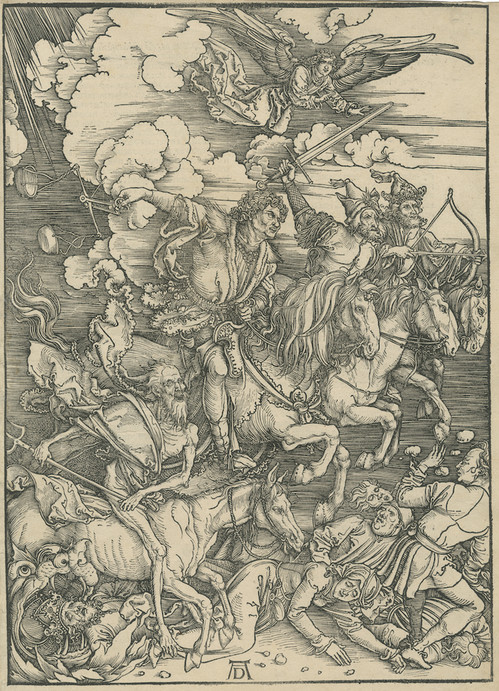The Sidney and Lois Eskenazi Museum of Art is pleased to announce the summer opening of Albrecht Dürer: Apocalypse and Other Masterworks from Indiana University Collections, the first-ever exhibition to survey the university’s impressive holdings by this important and perennially popular Old Master.
Soon after assuming his post in 1896 as Indiana University’s first art instructor, Alfred Mansfield Brooks acquired a small selection of prints by the Albrecht Dürer (Germany, 1471–1528) for study and exhibition in his classroom. Today, these works are among more than fifty by the pioneering Renaissance printmaker in IU collections.
Drawing on the collections of both the Eskenazi Museum of Art and the Lilly Library, the exhibition will feature engravings, etchings, and woodcuts spanning the length of Dürer’s career, in addition to early printed books illustrated and, in one case, authored by the artist. A small but revealing choice of works by sixteenth-century copyists and imitators rounds out this selection, affording additional insights into Dürer’s powerful influence and legacy.
“Dürer’s ability to infuse black-and-white images on paper with a truly remarkable amount of depth, detail, and drama has kept viewers enthralled and coming back for more generation after generation. As a bridge between the Italian and Northern Renaissance traditions, he created a graphic vocabulary that pushed his imagery into a whole new realm,” said Nanette Esseck Brewer, Lucienne M. Glaubinger Curator of Works on Paper at the Eskenazi Museum of Art.
Among the most compelling highlights is the Lilly’s complete Latin edition of the artist’s 1498 Apocalypse, a rarity seldom found in American libraries and museums. Recently unbound for conservation, the fifteen large-scale woodcuts and title page from this groundbreaking publication will be on individual display here for the first time. Apocalypse thrust Dürer into the international spotlight almost from the start of his career, bringing to the woodcut medium an unprecedented sophistication and startling audiences with its dynamic, suspenseful vision of end times during an anxious era of tectonic cultural shift.
“As is the case with many of the most famous fifteenth-century books in the Lilly Library, including the New Testament of the Gutenberg Bible, Dürer’s Apocalypse came to the library as part of the book and manuscript collection of George A. Poole, Jr., which was acquired by Indiana University in 1958,” notes the Lilly’s director Joel Silver. “We’re very pleased that these remarkable woodcuts will be a part of this exhibition showcasing Dürer’s life and work.” Two additional books from Poole’s important collection will also be featured, including Dürer’s important treatise Instruction in Measurement, and the Latin edition of the Nuremberg Chronicle, another groundbreaking publication in the history of book illustration.
Other highlights include later works made at the height of Dürer’s career, including his “Master Engravings”: Knight, Death, and the Devil, Melencolia I, and Saint Jerome in His Study—superb impressions of which are in the Eskenazi Museum’s collection. Prized as much for their formal beauty and complexity, as for their soulful and often cryptic play of imagery, the “Master Engravings” are almost irrefutably the most-discussed prints in the history of Western Renaissance art, debated even today among scholars. In addition to these works, the museum’s holdings feature many other well-known prints, including Adam and Eve, Nemesis (The Great Fortune), and The Sea Monster; one of Dürer’s few known etchings, The Cannon; and his complete Engraved Passion. While exploring the artist’s mastery of various print techniques, the exhibition examines his religious, mythological, and secular imagery, including some variations on the same theme.
Curated by Fess Graduate Assistant Leah Marie Chizek under the mentorship of Nanette Esseck Brewer, the Eskenazi Museum of Art’s Lucienne M. Glaubinger Curator of Works on Paper, the exhibition will be on view from Thursday, July 1, through Sunday, December 19, 2021, in the Rhonda and Anthony Moravec Gallery, Center for Prints, Drawings, and Photographs. The exhibition is supported in part by the Anthony J. and Rhonda L. Moravec Museum of Art Endowment.



